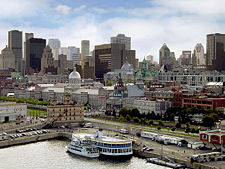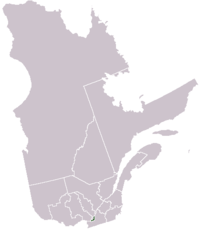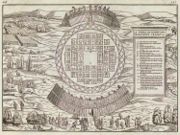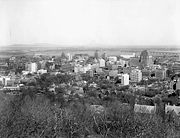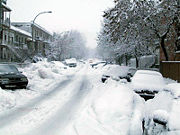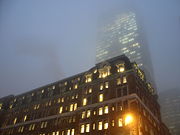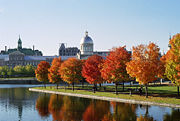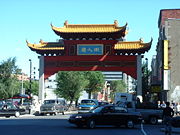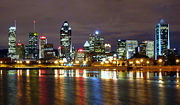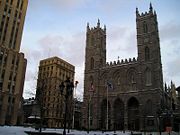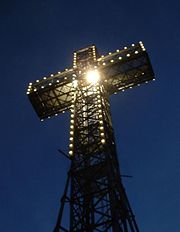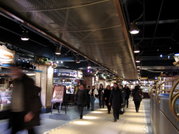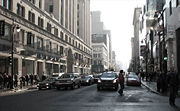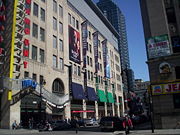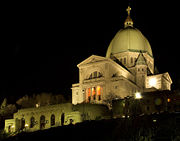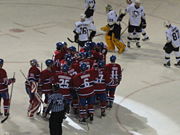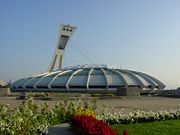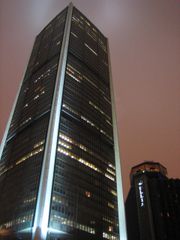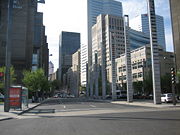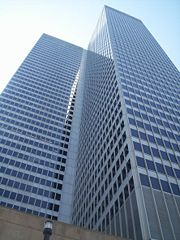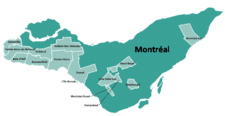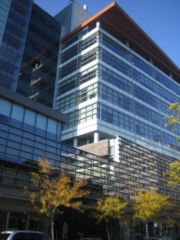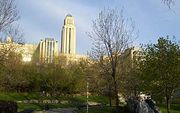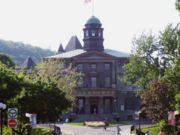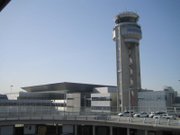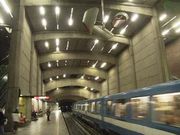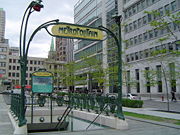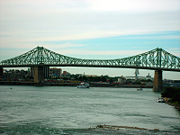Montreal
2008/9 Schools Wikipedia Selection. Related subjects: Cities; North America
| Montreal | |||
| — City — | |||
| Ville de Montréal | |||
| Montreal skyline | |||
|
|||
| Nickname: 5-1-4, MTL, City of Saints | |||
| Motto: Concordia Salus ("well-being through harmony") | |||
| Location of Montreal in Quebec | |||
| Coordinates: | |||
|---|---|---|---|
| Country | Canada | ||
| Province | Quebec | ||
| Region | Montréal | ||
| Founded | 1642 | ||
| Established | 1832 | ||
| Government | |||
| - Mayor | Gérald Tremblay | ||
| - Language | French (official) | ||
| Area | |||
| - City | 365.13 km² (140.98 sq mi) | ||
| - Urban | 1,677 km² (647 sq mi) | ||
| - Metro | 4,259 km² (1,644 sq mi) | ||
| Highest elevation | 233 m (764 ft) | ||
| Lowest elevation | 6 m (20 ft) | ||
| Population (2006) | |||
| - City | 1,854,442 ( Ranked 2nd) | ||
| - Density | 4,439/km² (11,496/sq mi) | ||
| - Urban | 3,316,615 | ||
| - Metro | 3,635,571 | ||
| - Demonym | Montrealer (English), Montréalais / Montréalaise (French) | ||
| Time zone | Eastern (EST) ( UTC-5) | ||
| - Summer ( DST) | EDT ( UTC-4) | ||
| Postal code span | H | ||
| Area code(s) | (514) and (438) | ||
| Website: Ville de Montréal | |||
Montreal, or Montréal in French, ( pronounced /ˌmɒ̃ʀeˈal/ in French, /ˌmʌntɹiːˈɑːl/ in English) is the largest city in the Canadian province of Quebec and the second-largest city in Canada. Montreal was the largest city in Canada up until the 1970s, when it was eclipsed in size and importance by Toronto. Originally called Ville-Marie ('City of Mary'), some historians think the city takes its present name from the Mont Réal (as it was pronounced in Middle French, or Mont Royal / Mount Royal in present French), the three-head hill at the heart of the city, whose name was also initially given to the island on which the city is located.
The official language of Montreal is French as defined by the city's charter. It is among the five largest French-speaking cities in the world. As of the 2006 Canadian Census, 1,620,693 people resided in the city of Montreal proper. The population of the Montreal Census Metropolitan Area (also known as Greater Montreal Area) was 3,635,571 at the same 2006 census. In the census metropolitan area, French is the language most spoken at home by 70.5% of the population (as of 2006 census). In 2007, Forbes Magazine ranked Montreal as the 10th cleanest city in the world. In the June 19th, 2008 edition of London based Monocle Magazine, Montreal was ranked 16th in a list of the world's 25 most liveable cities. Contributing factors included a strong-arts community, booming aerospace industry and a vast network of free wireless internet.
History
There is archaeological evidence of various nomadic native peoples occupying the island of Montreal for at least 2,000 years before the arrival of Europeans. The St. Lawrence Iroquoians established the village of Hochelaga at the foot of Mount Royal. The French explorer Jacques Cartier visited Hochelaga on October 2, 1535, claiming the St. Lawrence Valley for France. He estimated the population to be "over a thousand".
Seventy years later, French explorer Samuel de Champlain reported that the St. Lawrence Iroquoians and their settlements had disappeared altogether from the St. Lawrence valley, likely due to inter-tribal wars, European diseases and out-migration. Champlain established in 1611 a fur trading post on the Island of Montreal, on a site initially named La Place Royale, at the confluence of Saint-Pierre river and St-Lawrence river, where present-day Pointe-à-Callière stands.. In 1639, Jérôme Le Royer de La Dauversière obtained the Seigneurial title to the Island of Montreal in the name of the Société de Notre-Dame de Montréal to establish a Roman Catholic mission for evangelizing natives. Paul Chomedey de Maisonneuve was the governor of the colony.
Ville-Marie became a centre for the fur trade and a base for further French exploration in North America. It remained a French colony until 1760, when it was surrendered to Great Britain.
Montreal was incorporated as a city in 1832. The opening of the Lachine Canal permitted ships to bypass the unnavigable Lachine Rapids, while the construction of the Victoria Bridge established Montreal as a major railway hub. By 1860, it was the largest city in British North America and the undisputed economic and cultural centre of Canada.
Montreal was the capital of the Province of Canada from 1844 to 1849, but lost its status when a Tory mob burnt down the Parliament building to protest passage of the Rebellion Losses Bill.
After World War I, the Prohibition movement in the United States turned Montreal into a haven for Americans looking for alcohol. Unemployment remained high in the city, and was exacerbated by the Stock Market Crash of 1929 and the Great Depression. Canada began to recover from the Great Depression in the mid-1930s, when skyscrapers such as the Sun Life Building began to appear.
During World War II, Mayor Camillien Houde protested against conscription and urged Montrealers to disobey the federal government's registry of all men and women. Ottawa was furious over Houde's insubordination and held him in a prison camp until 1944, when the government was forced to institute conscription (see Conscription Crisis of 1944).
Montreal's population surpassed one million in the early 1950s. The Saint Lawrence Seaway opened in 1959, allowing vessels to bypass Montreal: a development that would in time help to spell the end of the city's economic dominance. However, the 1960s saw continued growth, including Expo 67, the construction of Canada's tallest skyscrapers, new expressways and the Montreal Metro system.
The 1970s ushered in a period of wide-ranging social and political changes, stemming in large part from the concerns of the French-Canadian majority about the conservation of their culture and language, given the traditional predominance of the English-Canadian minority in the business arena. The October Crisis and the election of the separatist political party, the Parti Québécois, resulted in major political, ethnic and linguistic shifts. Despite hosting the 1976 Summer Olympics, Montreal lost its title of Canada's largest and most influential city to Toronto.
During the 1980s and early 1990s, Montreal experienced a slower rate of economic growth than many other major Canadian cities. By the late 1990s, however, Montreal's economic climate had improved, as new firms and institutions began to fill the traditional business and financial niches.
Montreal was merged with the 27 surrounding municipalities on the Island of Montreal on January 1, 2002. The merger created a unified city of Montreal which covered the entire island of Montreal. This move proved unpopular, and several former municipalities, totalling 13% of the population of the island, voted to leave the newly unified city in separate referendums in June 2004. The demerger took place on January 1, 2006, leaving 15 municipalities on the island, including Montreal.
Geography
Montreal is located in the southwest of the province of Quebec, approximately 275 kilometres (168 miles) southwest of Quebec City, the provincial capital, and 167 kilometres (104 mi) east of Ottawa, the federal capital. It also lies 502 kilometres (312 mi) northeast of Toronto, 407 kilometres (253 mi) northwest of Boston and 530 kilometres (329 mi) directly north of New York City.
The city is located on the central and eastern portions of the Island of Montreal at the confluence of the Saint Lawrence and Ottawa Rivers. The port of Montreal lies at one end of the Saint Lawrence Seaway, which is the river gateway that stretches from the Great Lakes into the Atlantic Ocean. Montreal is defined by its location in between the St. Lawrence river on its south, and by the Rivière des Prairies on its north. The city is named after the most prominent geographical feature on the island, a three-head hill called Mount Royal.
Montreal is at the centre of the Montreal Metropolitan Community, and is bordered by the city of Laval to the north, Longueuil to the south, Repentigny to the east and the West Island municipalities to the west. The anglophone enclaves of Westmount, Montreal West, Hampstead, Côte Saint-Luc, the Town of Mount Royal and the francophone enclave Montreal East are all entirely surrounded by the city of Montreal.
Climate
Montreal lies at the confluence of several climatic regions. Usually, the climate is classified as humid continental or hemiboreal ( Köppen climate classification Dfb).
Precipitation is abundant with an average snowfall of 2.25 metres (84 in) per year in the winter. Regular rainfall throughout the year averages 900 mm (35.3 in). Summer is the wettest season statistically, but it is also the sunniest.
The coldest month of the year is January which has a daily average temperature of −10.4 °C (13 °F) — averaging a daily low of −14.9 °C (5.2 °F), colder than either Moscow (-10 °C) or Saint Petersburg (-6 °C). Due to wind chill, the perceived temperature can be much lower than the actual temperature, and wind chill factor is often included in Montreal weather forecasts. The warmest month is July which has an average daily high of 26.3 °C (79.3 °F); lower nighttime temperatures make an average of 20.9 °C (69.6 °F) thus air exchangers often achieve the same result as air conditioners. The lowest temperature ever recorded was −37.8 °C (−36.0 °F) on 15 January 1957 and the highest temperature ever was 37.6 °C (99.7 °F) on 1 August 1975. High humidity is common in the summer which makes the perceived temperature higher than the actual temperature. In spring and autumn, rainfall averages between 55 and 94 millimetres (2.2 and 3.7 in) a month. Some snow in spring and autumn is normal. Similarly, late heat waves as well as " Indian summers" are a regular feature of the climate.
2006 was noted as the only year in the history of Montreal when there was more rain than there was snow. There were 122.3 cm (48.1 in) of snow, and there were 122.5 cm (48.2 in) of rain. That year, Montreal received more rain than Vancouver, British Columbia.
| Weather averages for Montreal, Quebec | |||||||||||||
|---|---|---|---|---|---|---|---|---|---|---|---|---|---|
| Month | Jan | Feb | Mar | Apr | May | Jun | Jul | Aug | Sep | Oct | Nov | Dec | Year |
| Average high °C | -5.7 | -3.9 | 2.2 | 10.7 | 19.0 | 23.6 | 26.2 | 24.8 | 19.7 | 12.7 | 5.3 | -2.2 | 11.1 |
| Average low °C | -14.7 | -12.9 | -6.7 | 0.6 | 7.7 | 12.7 | 15.6 | 14.3 | 9.4 | 3.4 | -2.1 | -10.4 | 1.4 |
| Precipitation mm | 78.3 | 61.5 | 73.6 | 78.0 | 76.3 | 83.1 | 91.3 | 92.7 | 92.6 | 77.8 | 92.6 | 81.3 | 978.9 |
| Average high °F | 21.7 | 25.0 | 36.0 | 51.3 | 66.2 | 74.5 | 79.2 | 76.6 | 67.5 | 54.9 | 41.5 | 28.0 | 52.0 |
| Average low °F | 5.5 | 8.8 | 19.9 | 33.1 | 45.9 | 54.9 | 60.1 | 57.7 | 48.9 | 38.1 | 28.2 | 13.3 | 34.5 |
| Precipitation inches | 3.1 | 2.4 | 2.9 | 3.1 | 3.0 | 3.3 | 3.6 | 3.6 | 3.6 | 3.1 | 3.6 | 3.2 | 38.5 |
| Source: Environment Canada 2006-12-18 | |||||||||||||
Cityscape
Architecture
For over a century and a half, Montreal was the industrial and financial centre of Canada. The variety of buildings included factories, elevators, warehouses, mills, and refineries which today provide a legacy of historic and architectural interest, especially in the downtown area and the Old Port area.
Today there are also many historical buildings in Old Montreal still in their original form: Notre-Dame de Montréal Basilica, Bonsecours Market, and the impressive 19th-century headquarters of all major Canadian banks on Saint Jacques Street (formerly Saint James Street). Saint Joseph's Oratory, completed in 1934, Ernest Cormier's Art Deco Université de Montréal main building, the landmark Place Ville Marie office tower, the controversial Olympic Stadium and surrounding structures, are but a few notable examples of 20th century architecture.
Pavilions designed for the 1967 International and Universal Exposition, popularly known as Expo 67, featured a wide range of architectural designs. Though most pavilions were temporary structures, several remaining structures have become Montreal landmarks, including the geodesic dome US Pavilion, now the Montreal Biosphère, as well as Moshe Safdie's striking Habitat 67 apartment complex.
The Montreal Metro is filled with a profusion of public artwork by some of the biggest names in Quebec culture. The design and ornamentation of each station in the Metro system is unique.
In 2006, the city was recognized by the international design community as a UNESCO City of Design, one of the three world design capitals.
Neighbourhoods
Downtown Montreal
Downtown Montreal lies at the foot of Mount Royal, most of which is a major urban park, and extends toward the St Lawrence River. It is located entirely within the Ville Marie borough. The Downtown area contains dozens of notable skyscrapers — which bylaws restrict to the height of Mount Royal — including the aforementioned 1000 de La Gauchetière and 1250 René-Lévesque. The Tour de la Bourse (Stock Exchange Tower) is also another significant building in Montreal, and is home to the Montreal Exchange, which trades in derivatives such as futures contracts and options. The Montreal Exchange was the first stock exchange in Canada. In 1999 all stock trades were transferred to Toronto in exchange for exclusivity in derivatives trading.
Place Ville-Marie, an I. M. Pei-designed cruciform office tower built in 1962, sits atop an underground shopping mall that forms the nexus of Montreal's underground city, the world's largest, with indoor access to over 1,600 shops, restaurants, offices, businesses, museums and universities, as well as metro stations, train stations, bus terminals, and tunnels extending all over downtown. The central axis for downtown is Saint Catherine Street, Canada's busiest commercial artery. Other major streets include Sherbrooke, René Lévesque, Peel, de la Montagne, de Maisonneuve and Crescent. The downtown Ville-Marie borough includes two islands, Île Ste. Hélène and Île Notre-Dame. The man-made Notre Dame island hosts the Canadian Grand Prix Formula One auto race, as well as a NASCAR race. La Ronde, the sole amusement park in the Montreal area, is located on Île Sainte-Hélène and is home to the Montreal Fireworks Festival in the summer.
Old Montreal
Old Montreal (French: Vieux-Montréal) is a historic area located southeast of downtown containing many different attractions such as the Old Port of Montreal, Place Jacques-Cartier, Montreal City Hall, the Bonsecours Market, Place d'Armes, Pointe-à-Callière Museum, the Notre-Dame de Montréal Basilica, and the Montreal Science Centre.
Architecture and cobbled streets in Old Montreal have been maintained or restored and are frequented by horse-drawn calèches carrying tourists. Old Montreal is accessible from the downtown core via the underground city and is served by several STM bus routes and metro stations, ferries to the South Shore and a network of bicycle paths.
Old Montreal was once a worldwide port, but shipping has been moved further east to a new larger site, leaving the Old Port as a historical area. The newer port is now the biggest container port in North America. The riverside area adjacent to Old Montreal is known as the Old Port. It is now a recreational and historical area maintained by Parks Canada.
Mount Royal
The mountain is the site of Mount Royal Park (officially Parc du Mont-Royal), one of Montreal's largest greenspaces. The park, most of which is wooded, was designed by Frederick Law Olmsted, who also designed New York's Central Park, and inaugurated in 1876.
The park contains two belvederes, the more prominent of which is the Kondiaronk Belvedere, a semicircular plaza with a chalet, overlooking downtown Montreal. Other features of the park are Beaver Lake, a small man-made lake; a short ski slope; a sculpture garden; Smith House, an interpretive centre; and a well-known monument to Sir George-Étienne Cartier. The park hosts athletic, tourist, and cultural activities.
The mountain is also home to two major cemeteries, Notre-Dame-des-Neiges (founded in 1854) and Mount Royal (1852). Mount Royal Cemetery is a 165 acres (67 ha) terraced cemetery on the north slope of Mount Royal in the borough of Outremont. Cimetière Notre-Dame-des-Neiges is much larger, predominantly French-Canadian and officially Catholic. More than 900,000 people are buried there.
Mount Royal Cemetery contains more than 162,000 graves and is the final resting place for a number of notable Canadians. It includes a veterans section with several soldiers who were awarded the British Empire's highest military honour, the Victoria Cross. In 1901 the Mount Royal Cemetery Company established the first crematorium in Canada.
The name of the city of Montreal derives from mont Réal, an orthographic variant introduced either in French, or by an Italian map maker ("Mount Royal" is monte Reale in Italian). The name had been unofficially applied to the city, formerly Ville-Marie, by the 18th century.
The first cross on the mountain was placed there in 1643 by Paul Chomedey de Maisonneuve, the founder of the city, in fulfilment of a vow he made to the Virgin Mary when praying to her to stop a disastrous flood. Today, the mountain is crowned by a 31.4 m (103 ft) high illuminated cross, installed in 1924 by the Société Saint-Jean-Baptiste and now owned by the city. It was converted to fibre-optic light in 1992. The new system can turn the lights red, blue, or purple, the last of which is used as a sign of mourning between the death of the Pope and the election of the next.
Underground City
Extending all over downtown is Montreal's Underground City (French: La ville souterraine), a set of pedestrian levels built to cross under streets, thereby connecting buildings to each other. It is also known as the indoor city (ville intérieure), as not all of it is underground. The connections are considered tunnels architecturally and technically, but have conditioned air and good lighting as any building's liveable space does. Many tunnels are large enough to have shops on both sides of the passage. With over 32 kilometres (20 mi) of tunnels spread over more than twelve square kilometres (5 sq mi), connected areas include shopping malls, hotels, banks, offices, museums, universities, seven metro stations, two commuter train stations, a regional bus terminal and the Bell Centre amphitheatre and arena. There are more than 120 exterior access points to the underground city. Each access point is an entry point to one of 60 residential or commercial complexes comprising 3.6 square kilometres (1.4 sq mi) of floor space, including 80% of all office space and 35% of all commercial space in downtown Montreal. In winter, some 500,000 people use the underground city every day. Because of its Underground City, Montreal is often referred to as "Two Cities in One."
Culture
Montreal was referred to as "Canada's Cultural Capital" by Monocle Magazine. It is additionally the cultural centre of Quebec, and of French-speaking North America as a whole. The city is Canada's centre for French language television productions, radio, theatre, film, multimedia and print publishing. The Quartier Latin is a neighbourhood crowded with cafés animated by this literary and musical activity. The local English-speaking artistic community nevertheless contributes dynamically to the culture of Montreal, and intense collaborations exist between all Montreal communities. The result is a dynamic musical scene, ignited by the presence of numerous musical festivals, that melds different musical styles and traditions. English theatre struggled but survived with the Centaur Theatre. Ethnic theatre, by the 1970s, began to be a force with the Black Theatre Workshop, the Yiddish Theatre established at the Saidye Bronfman Centre and the Teesri Duniya Theatre. In the late 1990s, Montreal started to become a hotspot for low-budget independent English theatre with companies such as Optative Theatrical Laboratories, MainLine Theatre, Gravy Bath Theatre, Sa Booge, Persephone, Pumpkin Productions, and Tableau D'Hôte Theatre adding to the scene.
A cultural heart of classical art and the venue for many summer festivals, the Place des Arts is a complex of different concert and theatre halls surrounding a large open-spaced square in the downtown. The Place des Arts harbours the headquarters of the Montreal Symphony Orchestra (OSM: Orchestre Symphonique de Montréal), which performs in its halls regularly. The OSM is one of the world's foremost orchestras, most remembered for the quality of its performance of the repertoire of Maurice Ravel under conductor Charles Dutoit. Since 2006, the OSM has a new conductor, the American Kent Nagano. L'orchestre métropolitain and the chamber orchestra I Musici de Montréal are two other well-regarded Montreal orchestras. Also performing home at Place des Arts is the Opéra de Montréal and the city’s chief ballet company Les Grands Ballets Canadiens. In contemporary dance, Montreal has been active, particularly since the 1980s. Internationally recognized avant-garde dance troupes such as La La La Human Steps, O Vertigo, and the Fondation Jean-Pierre Perreault have toured the world and worked with international popular artists on videos and concerts. The intelligent integration of multi-discipline arts in choreography of these troupes has paved the way for the success of the Montreal-based Cirque du Soleil.
Festivals
The plaza on Place des Arts is the home of the most important events during several musical festivals, including the Montreal International Jazz Festival and Montreal Francofolies, a festival of French-speaking song artists. Each of the two festivals lasts seven-to-ten days and shows are presented in a wide variety of venues, from relatively small clubs to the large halls of Place des Arts. Some of the outdoor shows are held on cordoned-off streets while others are in terraced parks. The most popular festival, in terms of attendance, is the Just For Laughs Festival. A comedy festival held in both languages, it features comedians, humourists, and stand-ups from all over the world. The Montreal Fireworks Festival also attracts a lot of attention. On the evenings of competition, tens of thousands of people watch the fireworks for free on their roofs or from locations nearby the competition. Other festivals in Montreal include Pop Montreal, The Fringe Festival, la Fête des Neiges de Montréal, and Nujaz. Annual family-oriented events promoting health and cycling are also organized in the streets of Montreal. Parades are also popular in downtown Montreal.
The city is increasingly becoming known for its mainstream party festivals such as the Black and Blue Festival, the world's largest gay-benefit dance festival, attracting thousands of tourists to the city every Canadian Thanksgiving weekend, which raises money for HIV/AIDS and the gay community, as well as the Bal en Blanc held every Easter Sunday, also attracting thousands every year.
Tourism
During the period of Prohibition in the United States, Montreal became well-known as one of North America's "sin cities" with unparalleled nightlife, a reputation it still holds today. In part, its bustling nightlife is attributed to its relatively late "last call" (3 a.m.), and its many restaurants and after hours clubs that stay open well on into the morning. The large university population (195,000 students), the rarely enforced drinking age of 18, and the excellent public transportation system (a network of night buses replaces the metro between 1:00 and 5:00 a.m.) combine with other aspects of the Montreal culture to make the city's night life unique.
Crescent Street is "party central" for Montreal's tourist population, lying at the edge of the Concordia University campus. Throughout the summer, it features street fairs and festivals. The Formula 1 Canadian Grand Prix unofficially starts off Montreal's non-stop festival season in the summer. Crescent Street also features many clubs and bars. The clientele of Crescent nightclubs and bars are mostly students, tourists and in general a younger crowd looking for exhilaration and excitement. Most venues will play Top 40 music. The nearest subway stops are Peel, Lucien-L'Allier and Guy-Concordia.
Saint-Laurent Boulevard, known locally as "The Main", is one of the best places to find nightlife, with many bars and nightclubs and a wide range of restaurants. Saint-Laurent street night spots are often less mainstream than those on Crescent street, with a great variety: from Top 40 and urban music to electronica and techno, from underground and alternative rock to live bands. South of Prince Arthur Street, toward Sherbrooke Street, one is likely to encounter a "posher" clientele. From Prince Arthur Street north (to Avenue du Mont-Royal and beyond), one should expect to rub shoulders with an "edgier" crowd. The nearest subway stops are Saint-Laurent on the green line and Sherbrooke to Laurier on the orange line.
Another highly notable nightlife area is the Plateau Mont-Royal neighbourhood, with most of the bars, restaurants and nightclubs centred around Saint-Denis Sreet. and Mount Royal Ave.
Montreal is also one of the biggest gay destinations in North America with a flourishing Gay village, the largest of its kind on the North American continent, which houses three of the city's most popular clubs, Unity, Parking and Sky, along with dozens of restaurants and shops.
Cuisine
Montreal's culinary landscape is perhaps most influenced by the multinational fabric of its allophone communities. Italian, Greek, Portuguese and Jewish communities have contributed to the making up of Montreal's delicatessens and other restaurants. Jewish culinary contributions include the world-renowned Montreal-style smoked meat sandwiches and Montreal style bagels. Lebanese falafels and Japanese sushi have become appreciated cuisines. Due to all of the above, Montreal and its culinary landscape was the focus of Gourmet magazine's March 2006 issue. Since its inception, the magazine has focused its attention on a single city in only five other issues. Montreal's unique cuisine has also given birth to a number of Montreal-centric restaurants and restaurant chains, such as Dagwoods, Dic Ann's Hamburgers, Dunn's Famous and Lafleur Restaurants
Religion
Nicknamed la ville aux cent clochers ("the city of a hundred belltowers"), Montreal is renowned for its churches. Indeed, as Mark Twain once noted, "This is the first time I was ever in a city where you couldn't throw a brick without breaking a church window." The city has four Roman Catholic basilicas: Mary, Queen of the World Cathedral, the aforementioned Notre-Dame Basilica, St. Patrick's Basilica, and Saint Joseph's Oratory. The Oratory is the largest church in Canada, with the largest dome of its kind in the world after that of Saint Peter's Basilica in Rome.
Other well-known churches include Notre-Dame-de-Bon-Secours Chapel, which is sometimes called the Sailors' Church, and the Anglican Christ Church Cathedral, which was completely excavated and suspended above an excavated pit during the construction of part of the Underground City. All of the above are major tourist destinations, particularly Notre-Dame and the Oratory.
Sports and recreation
The biggest sport following in Montreal clearly belongs to hockey – and the city is famous for its hockey-hungry fans. The Montreal Canadiens are one of the Original Six NHL teams, and boast the greatest number of Stanley Cup championships at 24 (11 more than second place Toronto). The only other team in the four major North American sports leagues to have this many titles is baseball's New York Yankees, and their 26 titles.
Montreal has a storied baseball history. The city was the home of the Montreal Royals until 1960 and Jackie Robinson broke the baseball colour barrier with the Royals in 1946. Major League Baseball came to town in the form of the Montreal Expos in 1969. They played their games at Jarry Park until moving into Olympic Stadium in 1977. After 37 years in Montreal, the team relocated to Washington, DC in 2005 and re-branded themselves as the Washington Nationals. Various groups are trying to bring a Can-Am League team to the city to fill the void created by the departure of the Expos.
The Montreal Alouettes of the CFL draw packed crowds at the small but picturesque Molson Stadium for their regular season games. Late season and playoff games are played at the much larger, enclosed Olympic Stadium, which will also play host to the 2008 Grey Cup. The McGill Redmen, Concordia Stingers, and Université de Montréal Carabins play in the CIS university football league.
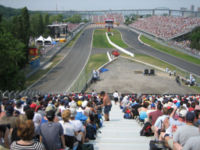
The city's USL First Division soccer team is called the Montreal Impact. They will open their brand new soccer-specific stadium in 2008 when they move to Saputo Stadium. There has been talk of the team moving to Major League Soccer in time for the 2010 season. The Montreal games of the FIFA 2007 FIFA U-20 World Cup were held at Olympic Stadium.
Montreal is the site of two high-profile racing events each year: the Canadian Grand Prix of F1 racing and a NASCAR race in the Nationwide Series. These races take place on the famous Circuit Gilles Villeneuve on Île Notre-Dame, where the Champ Car series also raced from 2002 until 2006.
Stade Uniprix (Uniprix Stadium) was built in 1993 and is used for the annual Rogers Cup Tennis Masters tournament. The ATP men's tennis tour and the Sony Ericsson WTA women's tennis tour switch between Montreal and Toronto every year.
Montreal was the host of the 1976 Summer Olympics. The Montreal Games were the most expensive in Olympic history, costing over $5 billion (equivalent to $20 billion in 2006). Bad planning led to the Games' cost far exceeding the budget, and the city just finished paying the debt off in December 2006. However, the games were still considered an immense success in the eyes of the IOC, and it furthered Montreal's reputation on the world stage. For a time, it seemed that the Olympic Games might no longer be a viable financial proposition. There was also a boycott by African nations to protest against a recent tour of apartheid-run South Africa by a New Zealand rugby side. The Romanian gymnast Nadia Comaneci won the women's individual all around gold medal with two of four possible perfect scores, thus giving birth to a gymnastics dynasty in Romania. Another female gymnast to earn the perfect score and three gold medals there was Nellie Kim of the USSR.
Montreal hosted the first ever World Outgames in the summer of 2006, attracting over 16,000 participants engaged in 35 sporting activities. They were the biggest sporting event in the city since the Summer Olympics of 1976.
Five beaches around the island, in addition to a network of parks that include one on the Mont Royal, offer a set of recreational activities enjoyed by the local population.
| Club | League | Sport | Venue | Established | Championships |
|---|---|---|---|---|---|
| Montreal Canadiens | NHL | Hockey | Bell Centre | 1909 | 24 |
| Montreal Alouettes | CFL | Football | Percival Molson Memorial Stadium Olympic Stadium |
1946–87 1996–today |
7 |
| Montreal Impact | USL | Soccer | Stade Saputo | 1993 | 2 |
| Montreal Expos | MLB | Baseball | Olympic Stadium | 1969–2005 (Now Washington Nationals) | 0 |
| Montreal Royal | ABA | Basketball | Centre Pierre Charbonneau | 2005 | 0 |
| Quebec Caribou | RCSL | Rugby | Dollard-des-Ormeaux | 1998 | 0 |
Economy
Montreal started out as the economic centre and largest city of Canada from the birth of the country up until the early 1970s when it was overcome by Toronto, due to political and economic crisis. Also, Toronto had been growing faster since the end of the Second World War. The loss of many headquarters and a large anglophone business community of about 300,000 people lessened Montreal's economic and social importance, and it stayed in a decline for over 15 years.
In the early 1990s, Montreal's economic recovery helped to place it as an important centre of commerce, industry, culture, finance, and world affairs.
Montreal industries include aerospace, electronic goods, pharmaceuticals, printed goods, software engineering, telecommunications, textile and apparel manufacturing, tobacco and transportation. The service sector is also strong and includes civil, mechanical and process engineering, finance, higher education, and research and development. In 2002, Montreal ranked as the 4th largest centre in North America in terms of aerospace jobs.
The Port of Montreal is the largest inland port in the world. As one of the most important ports in Canada, it remains a trans-shipment point for grain, sugar, petroleum products, machinery, and consumer goods. For this reason, Montreal is the railway hub of Canada and has always been an extremely important rail city; it is the eastern terminus of the Canadian Pacific Railway and home to the headquarters of the Canadian National Railway.
The headquarters of the Canadian Space Agency are located in Longueuil, southeast of Montreal. Montreal also hosts the headquarters of the International Civil Aviation Organization (ICAO, a United Nations body); the World Anti-Doping Agency (an Olympic body); the International Air Transport Association (IATA); the International Council of Graphic Design Associations (Icograda); the International Design Alliance (IDA); Gay and Lesbian International Chamber of Commerce, as well as some 60 other international organizations in various fields. It is also the leading Canadian city for its research output, fuelled in part by Montreal's four universities and numerous scientific research centres.
Montreal is also a centre of film and television production. The headquarters of Alliance Atlantis and five studios of the Academy Award-winning documentary producer National Film Board of Canada can be found here, as well as the head offices of Telefilm Canada, the national feature-length film and television funding agency. Given its eclectic architecture and broad availability of film services and crew members, Montreal is a popular filming location for feature-length films, and sometimes stands in for European locations. The city is also home to many recognized cultural, film and music festivals (Just For Laughs, Montreal Jazz Festival, and others), which contribute significantly to its economy. It is also home to one of the world's largest cultural enterprises, the Cirque du Soleil.
The video game industry is also booming in Montreal since 1997, coinciding with the opening of Ubisoft Montreal. Recently, the city has attracted world leading game developers and publishers studios such as Ubisoft, EA, Eidos Interactive, Artificial Mind and Movement, Strategy First, mainly because video games jobs have been heavily subsidized by the provincial government. Every year, this industry generates billions of dollars and thousands of jobs in the Montreal area.
Rio Tinto Alcan, Bombardier, CN, CGI Group, Air Canada, CAE, Saputo, Cirque du Soleil, Quebecor, Power Corporation, Bell Canada, SNC-Lavalin, Hydro-Québec, Abitibi-Consolidated, National Bank of Canada, ABB Canada, and many other corporations are headquartered in the Greater Montreal Area.
In 2006 Montreal was named a UNESCO City of Design, only one of three design capitals of the world (with the others being Berlin and Buenos Aires). This distinguished title recognizes Montreal's design community. Since 2005 the city is also a home for the International Design Alliance and the International Council of Graphic Design Associations (Icograda).
Demographics
According to Statistics Canada, at the 2006 Canadian census the city of Montreal proper had 1,620,693 inhabitants. However, 3,635,571 lived in the Montreal Census Metropolitan Area (CMA) at the same 2006 census, up from 3,451,027 at the 2001 census (within 2006 CMA boundaries), which means a population growth of +1.05% per year between 2001 and 2006. In the 2006 census, children under 14 years of age (621,695) constituted 17.1 percent, while inhabitants over 65 years of age (495,685) numbered 13.6 percent of the total population. People of European ethnicities formed the largest cluster of ethnic groups in Montreal, mostly of French, Italian, Irish, and English origins. Some 16.5 percent of the population of Greater Montreal are member of a visible minority (non-white) group. Canadians of African descent contribute to the largest visible minority group in greater Montreal, numbering some 169,065, which is the second-largest community of African-origin people in Canada, after Toronto. Other groups, such as Arabs, Latin American, South Asian, and Chinese are also large in number.
| 1931 | 1941 | 1951 | 1961 | 1971 | 1981 | 1991 | 1996 | 2001 | 2006 |
|---|---|---|---|---|---|---|---|---|---|
| 1,003,868 | 1,116,800 | 1,320,232 | 1,747,696 | 1,959,180 | 1,760,122 | 1,775,871 | 1,775,846 |
1,812,723 |
1,854,442 |
| 1996 | 2001 | 2006 | |
|---|---|---|---|
| French | 71.2% | 72.1% | 70.5% |
| English | 19.4% | 18.5% | 18.5% |
| Other language | 13.4% | 13.1% | 14.6% |
| Note that percentages add up to more than 100% because some people speak two or more languages at home. |
|||
In terms of mother tongue language (first language learned), the 2006 census reported that in the Greater Montreal Area, 66.5% spoke French as a first language, followed by English at 13.2%, while 0.8% spoke both as a first language. The remaining 22.5% of Montreal-area residents are allophones, speaking languages including Italian (3.5%), Arabic (3.1%), Spanish (2.6%), Creole (predominantly of Haitian origin) (1.4%), Chinese (1.2%), Greek (1.2%), Portuguese (0.9%), Romanian (0.7%), Vietnamese (0.7%), and Russian (0.5%). In terms of additional languages spoken, a unique feature of Montreal throughout Canada, noted by Statistics Canada, is the working knowledge of both French and English by most of its residents.
The Greater Montreal Area is overwhelmingly Roman Catholic, however, church attendance in Quebec is among the lowest in Canada. Historically Montreal has been a centre of Catholicism in North America with its numerous seminaries and churches, including the Notre-Dame Basilica, the Cathédrale Marie-Reine-du-Monde, and Saint Joseph's Oratory. Some 84.6 percent of the total population is Christian, largely Roman Catholic (74.5%), which is largely due to French, Italian and Irish origins. Protestants which include Anglican, United Church, Lutheran and other denominations number 7.0%, with a further 3.0% consisting mostly of Orthodox Christians, fuelled by a large Greek population. Due to the large number of non-European cultures, there is a diversity of non-Christian religions. Islam is the largest non-Christian group, with some 100,185 members, the second-largest concentration of Muslims in Canada, constituting 3%. The Jewish community in Montreal has a population of 88,765. In cities such as Côte-Saint-Luc and Hampstead, Jewish people constitute the majority, or a substantial part of the population. As recently as 1971 the Jewish community in Greater Montreal was as high as 109,480. Political and economic uncertainties led many to leave Montreal and the province of Quebec.
Government
The head of the city government in Montreal is the mayor, who is first among equals in the City Council. The mayor is Gérald Tremblay, who is a member of the Union des citoyens et des citoyennes de l'Île de Montréal (English: Montreal Island Citizens Union). The city council is a democratically elected institution and is the final decision-making authority in the city, although much power is centralized in the executive committee. The Council consists of 73 members from all boroughs of the city. The Council has jurisdiction over many matters, including public security, agreements with other governments, subsidy programs, the environment, urban planning, and a three-year capital expenditure program. The City Council is also required to supervise, standardize or approve certain decisions made by the borough councils.
Reporting directly to the City Council, the executive committee exercises decision-making powers similar to that of the cabinet in a parliamentary system and is responsible for preparing various documents including budgets and by-laws, submitted to the City Council for approval. The decision-making powers of the executive committee cover, in particular, the awarding of contracts or grants, the management of human and financial resources, supplies and buildings. It may also be assigned further powers by the City Council.
Standing committees are the council's prime instruments for public consultation. They are responsible for the public study of pending matters and for making the appropriate recommendations to the council. They also review the annual budget forecasts for departments under their jurisdiction. A public notice of meeting is published in both French and English daily newspapers at least seven days before each meeting. All meetings include a public question period. The standing committees, of which there are seven, have terms lasting two years. In addition, the City Council may decide to create special committees at any time. Each standing committee is made up of seven to nine members, including a chairman and a vice-chairman. The members are all elected municipal officers, with the exception of a representative of the government of Quebec on the public security committee.
The city of Montreal is only one component of the larger Communauté Métropolitaine de Montréal (English: Montreal Metropolitan Community or MMC), which is in charge of planning, coordinating, and financing economic development, public transportation, garbage collection and waste management, etc., across the metropolitan area of Montreal. The president of the CMM is the mayor of Montreal. The CMM covers 3,839 square kilometres (1,482 sq mi), with 3,635,700 inhabitants in 2005.
Education
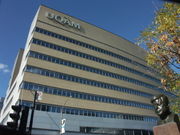
With access to six universities and twelve junior colleges in an 8 kilometre (5 mi) radius, Montreal has the highest concentration of post-secondary students of all major cities in North America (4.38 students per 100 residents, followed by Boston at 4.37 students per 100 residents).
There are two English-language universities in the city. McGill University is one of the oldest schools in Canada, a major research university, and has been rated as Canada's best university by various sources, and the twelfth best in the world by Quacquarelli Symonds. Concordia University is the other English-language university, created from the merger of Sir George Williams University and Loyola College.
There are also two French-language universities located in the city of Montreal. Université du Québec à Montréal (UQÀM) is the largest French-language university in the world. UQÀM generally specializes in liberal-arts. It has several separately run schools, notably École de technologie supérieure (ETS), École nationale d'administration publique (ENAP) and Institut National de la Recherche Scientifique (INRS). The other French-language university, Université de Montréal (UdeM) is a research university. The École Polytechnique de Montréal and the École des Hautes Études Commerciales de Montréal are two schools that are run by UdeM.
Additionally, two more French-language universities, Université de Sherbrooke and Université Laval have campuses in the nearby suburb of Longueuil on the south shore.
The education system in the province of Quebec is slightly different from other systems in North America. Between the high school and university levels, there is an additional college level called " CEGEP". It is at the same time a preparatory school (preparing students for admission to university) and a technical school (offering courses which lead to technical diplomas and specializations). In Montreal, seventeen CEGEPs offer courses in French and five in English.
English-language elementary and secondary public schools on Montreal Island are operated by the English Montreal School Board and the Lester B. Pearson School Board. French-language elementary and secondary public schools in Montreal are operated by the Commission scolaire de Montréal (CSDM), Commission scolaire Marguerite-Bourgeoys (CSMB) and the Commission scolaire Pointe-de-l'Île (CSPI).
Like many other cities, Montreal has been the scene of school shootings, the most recent of which was Dawson College shooting in September, 2006. The shooting was committed by a troubled young man and resulted in the death of a student. The most violent was the École Polytechnique massacre of 1989 in which fourteen young women were shot and killed by a male student. The Concordia University massacre of 1992 involved the killing of four faculty members by another professor who claimed they stole his work.
Infrastructure
Transportation
Montreal is a transportation hub for eastern Canada, with well-developed air, road, rail, and maritime links to the rest of Canada, as well as the United States and Europe.
Air
Montreal has two international airports, one for passenger flights only, and the other for cargo. Montréal-Pierre Elliott Trudeau International Airport (also known as Dorval Airport) in the City of Dorval serves all commercial passenger traffic and is the headquarters for Air Canada and Air Transat. To the north of the city is Montréal-Mirabel International Airport in Mirabel, which was envisioned as Montreal's primary airport but which now serves only cargo flights. In 2006, Montreal-Trudeau was the third busiest airport in Canada by passenger traffic, behind Toronto Pearson and Vancouver. It was fourth in aircraft movements, behind Toronto Pearson, Vancouver and Calgary. It handled 12,407,934 passengers in 2007 and 213,483 aircraft movements in 2006 and with 59% of its passengers being on non-domestic flights it is the busiest international airport in Canada. Trudeau airport serves over 100 destinations worldwide making it one of the most connected airports in North America. Airlines servicing Trudeau offer flights to Africa, Central America, the Caribbean, Europe, the United States, Mexico and other destinations within Canada. It is the only Canadian airport that offers non-stop service to Africa and it also contains the largest duty free shop in North America.
Other airports in the Montreal area serve military and civilian use.
Rail
VIA Rail, which is headquartered in Montreal, provides rail service to other cities in Canada, particularly to Quebec City and Toronto with several trains daily. Amtrak, the U.S. national passenger rail system, also provides service to Montreal, operating its Adirondack daily between Montreal and New York City. All intercity trains and most commuter trains operate out of Central Station. The rest of the commuter trains operate out of the Lucien-L'Allier Station.
Public local transport is served by a network of buses, subways, and commuter trains that extend across and off the island. The subway and bus system is operated by the Société de transport de Montréal. The commuter rail system is managed and operated by the Agence métropolitaine de transport, and extends across several municipalities.
Canadian Pacific Railway (CPR), which is now headquartered in Calgary, Alberta, was founded here in 1881. Its corporate headquarters occupied Windsor Station at 910 Peel Street until 1995. With the Port of Montreal kept open year round by icebreakers, lines to Eastern Canada became surplus, and now Montreal is the railway's eastern and intermodal freight terminus. CPR connects at Montreal with the Port of Montreal, the Delaware & Hudson Railway to New York, the Quebec-Gatineau Railway to Quebec City and Buckingham, the Montreal, Maine & Atlantic to Halifax, and CN Rail. The CPR's flagship train, The Canadian, once ran daily from Windsor Station to Vancouver, all passenger services have since been transferred to VIA Rail Canada, although CPR operates certain AMT trains under contract to the Quebec government.
Montreal-based Canadian National Railways (CN) was formed during the 1920s by the Canadian Government following a series of country-wide rail bankruptcies. CN was formed from the lines of the Grand Trunk, Midland and Canadian Northern Railways, and has risen to become CPR's chief rival in freight carriage in Canada. Like the CPR, CN has divested itself of passenger services in favour of VIA Rail Canada. CN operates the electric Mont Royal AMT line under contract to the Government of Quebec.
Mass transit
The STM bus network consists of 169 daytime and 20 night-time service routes, and provides adapted transport and limited wheelchair-accessible buses.
Montreal's Metro was inaugurated in 1966 and today has 68 stations spread out along its four lines. Each station was designed by different architects with individual themes and features original artwork, and the trains themselves run on rubber tires, making the system quieter than most. The project was initiated by Montreal Mayor Jean Drapeau, who would later bring the Summer Olympic Games to Montreal in 1976. The metro system has long had a station on the South Shore in Longueuil, and has only recently been extended to the city of Laval, north of Montreal.
Road
Like many major cities, Montreal has a problem with vehicular traffic congestion, especially from off-island suburbs such as Laval on Île Jésus, and Longueuil on the south shore. The width of the Saint Lawrence River has made the construction of fixed links to the south shore expensive and difficult. There are only four road bridges along with one road tunnel, two railway bridges, and a metro line. The far narrower Rivière des Prairies, separating Montreal from Laval, is spanned by eight road bridges (six to Laval and two directly to the north shore).
The island of Montreal is a hub for the Québec Autoroute system, and is served by Québec Autoroutes A-10 (known as the Bonaventure Expressway on the island of Montreal), A-15 (aka the Decarie Expressway south of the A-40 and the Laurentian Autoroute to the north of it), A-13 (aka Autoroute Chomedey), A-20, A-25, A-40 (part of the Trans-Canada Highway system, and known as "The Metropolitan" or simply "The Met" in its elevated mid-town section), A-520, and A-720 (aka the Ville-Marie Autoroute). Many of these Autoroutes are frequently congested at rush hour. However, in recent years, the government has acknowledged this problem and is working on long-term solutions to alleviate the congestion, such as re-routing traffic and expanding lanes.
Saint Lawrence Boulevard, also known as "The Main," divides Montreal into east and west sectors. Streets that cut across Saint Laurent Boulevard undergo a name change, in that Est or Ouest are appended to their names. Streets that do not cross the Main do not generally contain a cardinal direction at the end of their names.
Since Montreal is on an island, the directions used in the city plan do not precisely correspond with compass directions, as they are oriented to the geography of the island. North and south are defined on an axis roughly perpendicular to the St. Lawrence River and the Rivière des Prairies: North is towards the Rivière des Prairies, and south is towards the St. Lawrence. East and west directions are defined as roughly parallel to the St. Lawrence River (which flows southwest to northeast) and the Rivière des Prairies. East is downstream, and west is upstream.
Montreal also has a well developed network of bicycle paths. Bike rentals are available at the Old Port of Montreal, as well as quadricycles, inline skates, children trailers, and segways.
Partner cities
Montreal has partnership, twin or sister city agreements with the following cities:
| Country | City | County / District / Region / State | Date | |||
|---|---|---|---|---|---|---|
| Armenia | Yerevan | Yerevan | 1998 | |||
| China | Shanghai | Shanghai | 1985 | |||
| France | Lyon | Rhône-Alpes | 1979 | |||
| France | Paris | Île-de-France | 2006 | |||
| India | Lucknow | Uttar Pradesh | 2000 | |||
| Japan | |
Hiroshima | |
Hiroshima Prefecture | 1998 | |
| Philippines | Manila | Metro Manila | 2005 | |||
| South Korea | Busan | Yeongnam | 2000 |
